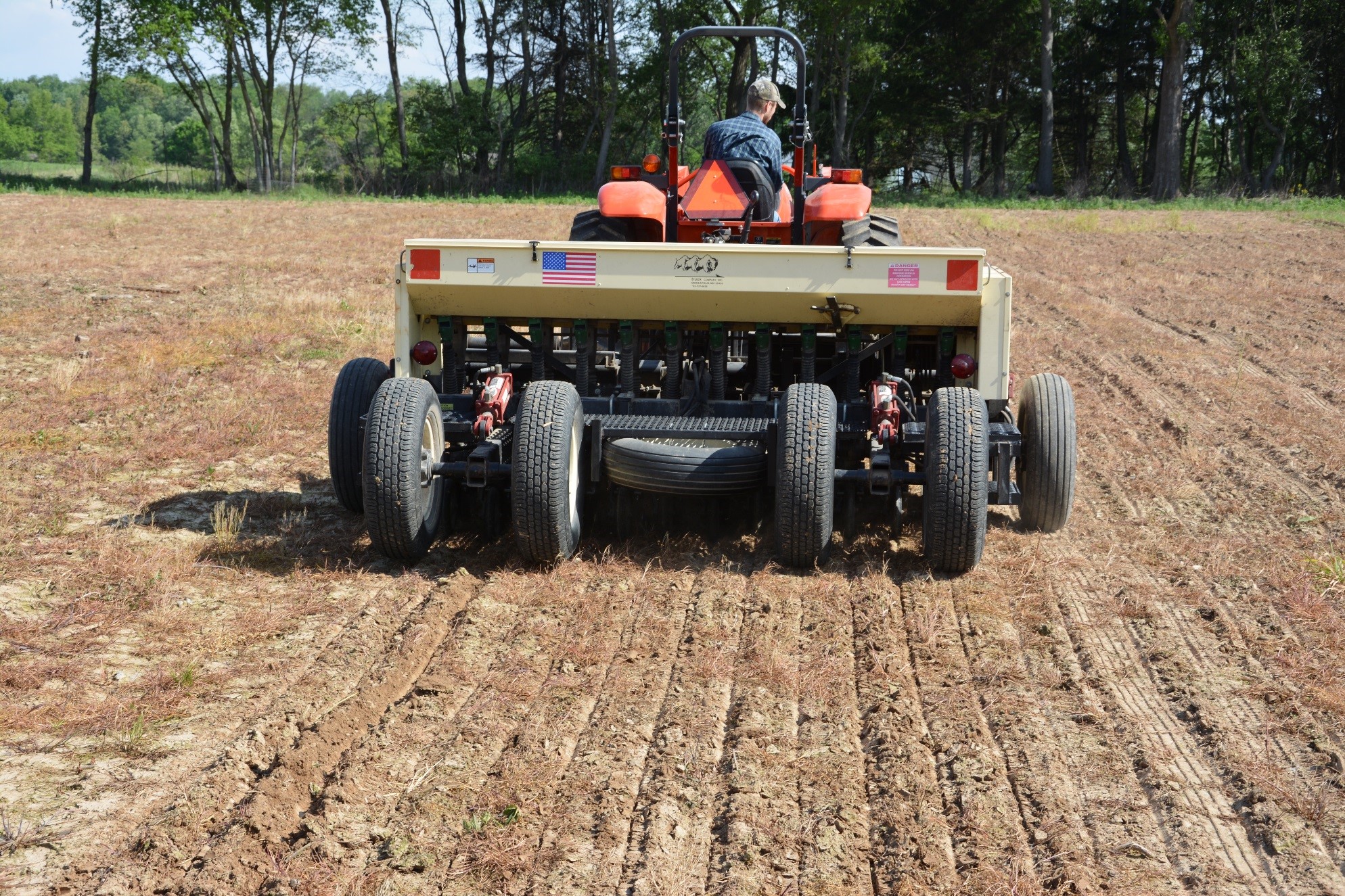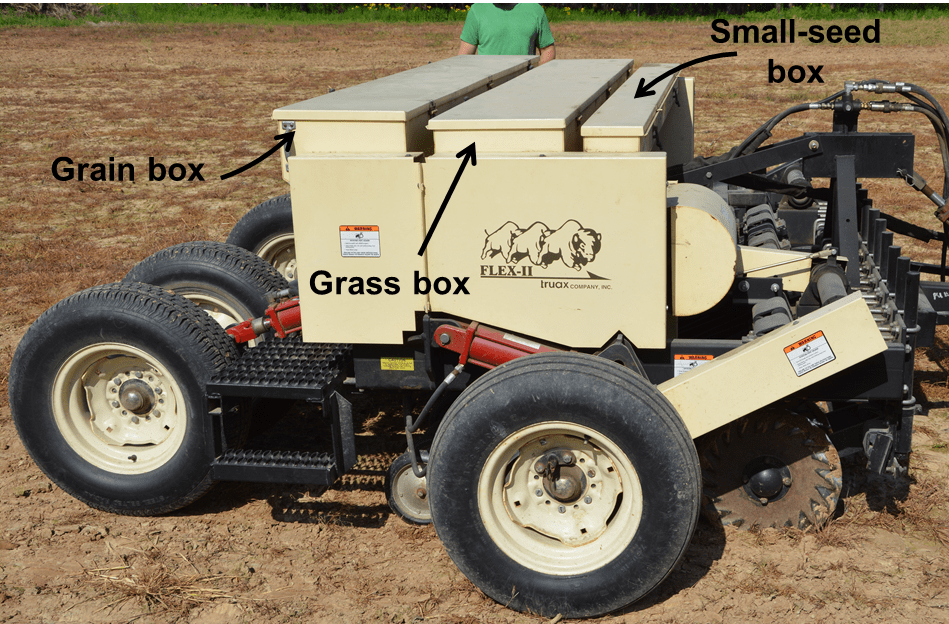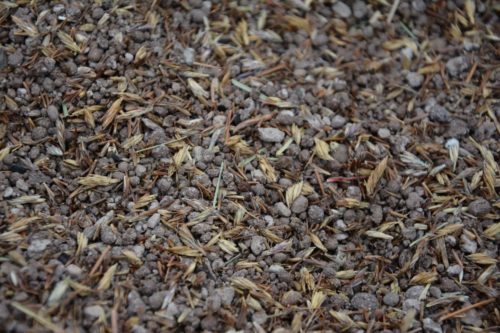 Purdue University - Extension - Forestry and Natural Resources
Purdue University - Extension - Forestry and Natural Resources
Seed Fillers and Carriers for Planting Native Warm-Season Grasses and Forbs
Seeding rates for native warm-season grass and forb mixtures (NWSG) have changed drastically over time. In the past, native grasses were planted without forbs at rates exceeding 10 lbs/ac. This may be ideal from a forage production standpoint, but this created dense stands of native grass with little to no forb component and lacked benefits to most wildlife.
Mixtures have shifted from heavy planting rates of tallgrass species with few forbs to reduced rates of mid-stature grasses with an abundance of forbs. Recommended seeding rates of some current mixtures may be lower than what no-till drills are capable of planting. In this case, fillers may be needed to increase the bulk weight of the seed to allow the equipment to plant at the correct rate.
Seed mixtures are also more commonly being established by broadcasting seed during late winter (frost seeding) using cyclone fertilizer spreaders. Broadcasting native warm-season grass and forb seed usually requires the use of a carrier to ensure the mixture flows correctly through the spreader and the seed is distributed evenly across the field.
Using fillers when no-till drilling native warm-season grass and forb mixtures
Planting native grass and forb mixtures with a no-till drill is the most common establishment method for NWSG plantings. It may be difficult to achieve the correct seeding rate with a no-till drill because of the combination of reduced bulk weight of dechaffed seed and reduced seeding rates of common mixtures. Fillers can be used to increase the bulk weight of native grass and forb seed if a drill cannot achieve the recommended seeding rate. Traditionally, native grass and forbs have been planted separately using the grass or fluffy-seed box for the native grass seed and the small-seed box for the forbs. However, if the seed has been cleaned and dechaffed it is common for seed companies to mix the seed and recommend it be planted together using the fluffy or grain box on a no-till drill. Fillers can be used when planting native grasses and forbs separately or when planting native grass and forb mixtures. Refer to the chart below for recommended fillers for the different seed boxes of a no-till drill.
Example:
We are planting a 10-acre field to a native warm-season grass and forb mixture using a no-till drill. The recommended seeding rate is 6 lbs/acre. The seed will be planted with the grain box of the drill, but the drill will only plant a minimum of 10 lbs/acre of our seed mixture.
10 acre field * 6 lbs/acre bulk seeding rate = 60 lbs of the seed mixture
Minimum seeding rate for the no-till drill is 10 lbs/acre = 10 lbs/acre * 10 acres = 100 lbs
We need to add a filler to increase the bulk weight of the seed mixture to be able to plant at the correct seeding rate. We added a 1:1 ratio (by weight) of cracked corn to our seed mixture:
60 lbs of seed + 60 lbs of cracked corn = 120 lbs of bulk weight for 10 acres
We now need to adjust our bulk seeding rate to account for the added crack corn.
120 lbs of bulk weight for 10 acres = 12 lbs/acre
We need to calibrate our drill to plant 12 lbs/acre in order to plant 6 lbs/ac of our initial seed mixture.
Generally, you should use a 1:1 ratio (by weight) of filler-to-seed, but in some cases you may need to use a higher ratio (e.g., 2:1, 3:1, or 4:1 filler-to-ratio) to achieve the correct seeding rate.
Using carriers when broadcasting native warm-season grass and forb mixtures
Broadcasting native warm-season grass and forbs mixtures is most commonly accomplished with a cyclone fertilizer spreader. These spreaders may have issues broadcasting the native grass and forb seed. The 2 main issues are: (1) the seed is not heavy enough to flow through the spreader and (2) the seeds of various size will settle and will not be spread evenly across the field. Carriers will add more bulk weight to the native grass seed and will help ensure the seed stays mixed across the field. Common carriers that are used with native grasses are cracked corn, pelletized lime, wheat, or oats. The recommended rates of common carriers are in the table below:
Pelletized lime
Wheat
Oats
Cracked corn
200 lbs/acre
40 lbs/acre
32 lbs/acre
1:1 ratio of seed-to-cracked corn by weight
Table adapted from the publication Warm season grass establishment,
Indiana Department of Natural Resources, 2006.
Example:
We plan to broadcast a native grass and forb mixture on a 10-acre field. The recommended bulk seeding rate is 6 lbs/acre.
10 acre field * 6 lbs/acre bulk seeding rate = 60 lbs of the seed mixture
We need to add a carrier to the mixture to increase the bulk weight of the seed mixture. We plan to add 200 lbs of pelletized lime per acre:
200 lbs/ac of lime * 10 acres = 2000 lbs of lime
60 lbs of seed + 2000 lbs of pelletized lime = 2060 lbs of bulk weight for 10 acres
We now need to adjust our bulk seeding rate to account for the added pelletized lime.
2060 lbs of bulk weight for 10 acres = 206 lbs/acre
We need to calibrate the spreader to broadcast 206 lbs/acre in order to plant 6 lbs/acre of our seed mixture.
Conclusions
Planting native warm-season grass and forb mixtures at the correct rate is a critical step in ensuring a successful planting. Using fillers and carriers when establishing native warm-season grasses and forbs can help ensure the mixtures are planted at the proper rates, flow correctly through the seeding equipment, and ensure the seed is spread evenly across the field.
Other Resources:
Pure Live Seed: Calculations and Considerations for Wildlife Food Plots, Detailed Resource, Purdue Extension-FNR
Renovating Native Warm-Season Grass Stands for Wildlife: A Land Manager’s Guide, free pdf download
Calibrating a No-Till: FNR 556-WV, free pdf download
VIDEO: Calibrating a No-Till Drill for Conservation Plantings and Wildlife Food Plots
VIDEO: Frost Seeding to Establish Wildlife Food Plots & Native Grass and Forb Plantings
Printable Version:
PDF available for print: Seed Fillers and Carriers for Planting Native Warm-Season Grasses and Forbs (pdf 771.45) detail resource.
Moriah Boggess, Purdue Extension Wildlife Intern
Jarred Brooke, Purdue Extension Wildlife Specialist

Recent Posts
- New Indiana Woodland Steward Newsletter, Stumpage Timber Price Report
Posted: May 3, 2025 in Forestry, Timber Marketing, Woodlands - ID That Tree: Black Raspberry
Posted: May 2, 2025 in Forestry, Urban Forestry, Woodlands - Publication – Goldenrod Control
Posted: April 30, 2025 in Forestry, Invasive Plant Species, Wildlife - White-tailed Deer Impact on Indiana Woodlands, Hoosier Ag Today
Posted: April 29, 2025 in Wildlife, Woodlands - Top 10 Spring Flowering Shrubs, Purdue Landscape Report
Posted: April 28, 2025 in Gardening, Plants, Urban Forestry - HTIRC Continues to Protect Our Hardwood Forests
Posted: April 18, 2025 in Forestry, Timber Marketing, Woodlands - Tips to Manage Storm-Damaged Trees, Purdue Landscape Report
Posted: April 17, 2025 in Forests and Street Trees, How To, Urban Forestry - Liz Jackson Receives IHLA’s President’s Award, Featured in ANR Newsletter
Posted: in Forestry, Timber Marketing, Wildlife, Wood Products/Manufacturing, Woodlands - A Woodland Management Moment: Bottomland Forests
Posted: in Forests and Street Trees, Urban Forestry, Wildlife, Woodland Management Moment, Woodlands - When is the Peak Migration For Hummingbirds and How Can You Attract Them?
Posted: April 4, 2025 in How To, Wildlife
Archives
Categories
- Alert
- Aquaculture/Fish
- Aquatic/Aquaculture Resources
- Ask the Expert
- Christmas Trees
- Community Development
- Disease
- Drought
- Forestry
- Forests and Street Trees
- Gardening
- Got Nature for Kids
- Great Lakes
- How To
- Invasive Animal Species
- Invasive Insects
- Invasive Plant Species
- Land Use
- Natural Resource Planning
- Nature of Teaching
- Plants
- Podcasts
- Ponds
- Publication
- Safety
- Spiders
- Timber Marketing
- Uncategorized
- Urban Forestry
- Webinar
- Wildlife
- Wood Products/Manufacturing
- Woodland Management Moment
- Woodlands


